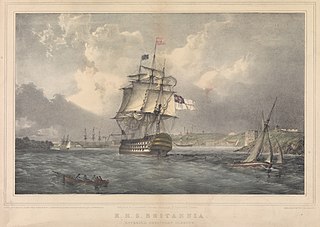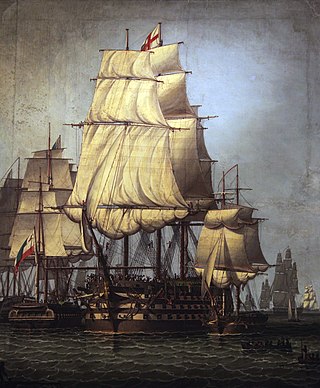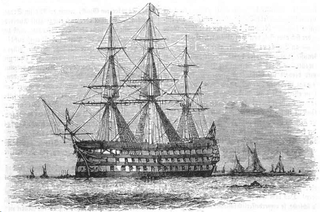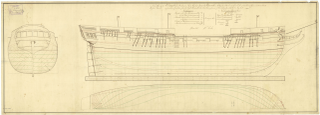
HMS Africa was a 64-gun third-rate ship of the line of the Royal Navy, launched by William Barnard at Barnard's Thames Yard in Deptford on 11 April 1781.
HMS Ganges was a 74-gun third-rate ship of the line of the Royal Navy, launched in 1782 at Rotherhithe. She was the first ship of the Navy to bear the name, and was the name ship of her class. She saw active service from 1782 to 1811, in Europe and the West Indies.

HMS Britannia, also known as Old Ironsides, was a 100-gun first-rate ship of the line of the Royal Navy.

Scipion was a 74-gun French ship of the line, built at Lorient to a design by Jacques Noel Sane. She was laid down as Orient in late 1798, and renamed Scipion in 1801. She was first commissioned in 1802 and joined the French Mediterranean fleet based at Toulon, in the squadron of Admiral Leissègues. Consequently, she was one of the ships afloat in that port when war with England reopened in May 1803. She participated in the Battle of Cape Finisterre and the Battle of Trafalgar. The British captured her in the subsequent Battle of Cape Ortegal. In 1810 she participated in the Java campaign, which in 1847 earned her surviving crew the Naval General Service Medal. She participated in the blockade of Toulon in 1813 and was paid off in 1814. She was broken up in 1819.

HMS Hannibal was a 74-gun third-rate ship of the line of the Royal Navy, launched on 15 April 1786, named after the Carthaginian general Hannibal. She is best known for having taken part in the Algeciras Campaign, and for having run aground during the First Battle of Algeciras on 5 July 1801, which resulted in her capture. She then served in the French Navy until she was broken up in 1824.

HMS Caledonia was a 120-gun first-rate ship of the line of the Royal Navy, launched on 25 June 1808 at Plymouth. She was Admiral Pellew's flagship in the Mediterranean.

HMS Duke was a 90-gun second-rate ship of the line of the Royal Navy, launched on 13 June 1682 at Woolwich Dockyard.

HMS Atlas was a 98-gun second-rate ship of the line of the Royal Navy, launched on 13 February 1782. She was a Duke-class ship of the line built at Chatham Dockyard by Nicholas Phillips.

HMS Bulwark was a 74-gun third-rate ship of the line of the Royal Navy, launched on 23 April 1807 at Portsmouth. She was designed by Sir William Rule as one of the large class 74s, and was the only ship built to her draught. She was built at Portsmouth Dockyard by Nicholas Diddams.

HMS Hero was a 74-gun third rate of the Royal Navy, launched on 18 August 1803 at Blackwall Yard.

HMS Queen Charlotte was a 104-gun first-rate ship of the line of the Royal Navy, launched on 17 July 1810 at Deptford. She replaced the first Queen Charlotte sunk in 1800.

HMS Trafalgar was ordered as a 98-gun second-rate ship of the line, re-rated as a 106-gun first-rate ship of the line whose keel was laid in 1813 and which was launched on 26 July 1820 at Chatham. She was designed by the Surveyors of the Navy, and was the only ship built to her draught.

HMS Waterloo was an 80-gun third-rate ship of the line, launched on 16 October 1818 at Portsmouth. She was designed by Henry Peake, and built by Nicholas Diddams at Portsmouth Dockyard and was the only ship built to her draught. She had originally been ordered as HMS Talavera, but was renamed on the stocks after the Battle of Waterloo.

HMS Aboukir was a 74-gun third-rate ship of the line of the Royal Navy, launched on 18 November 1807 at Frindsbury.
HMS Marlborough was a 74-gun third rate ship of the line of the Royal Navy, launched on 22 June 1807 at Deptford. In 1807, she helped escort the Portuguese royal family in its flight from Portugal to Brazil. In 1812 Marlborough became the flagship to Rear-Admiral Sir George Cockburn off Cadiz, from where she went to the North America Station and took part in the capture of Washington in August 1814.

HMS Vindictive was a 74-gun third-rate ship of the line of the Royal Navy, built by Nicholas Diddams at Portsmouth Dockyard and launched on 30 November 1813 at Portsmouth.

HMS Modeste was a 64-gun third rate ship of the line of the Royal Navy. She was previously the 64-gun Modeste, of the French Navy, launched in 1759 and captured later that year.

HMS Charles was a 96-gun first-rate ship of the line of the Royal Navy, built by Christopher Pett at Deptford Dockyard until his death in March 1668, then completed by Jonas Shish after being launched in the same month. Her name was formally Charles the Second, but she was known simply as Charles, particularly after 1673 when the contemporary Royal Charles was launched.

The Thames-class frigate was a 32-gun fifth-rate frigate class of eight ships of the Royal Navy based on the Richmond-class frigate designed by William Bately. The ships were ordered to the older design, which was of a smaller type of ship compared to more modern designs, so that they could be built quickly and cheaply in time to assist in defending against Napoleon's expected invasion of Britain. The class received several design changes to the Richmond class, being built of fir instead of oak, with these changes making the class generally slower and less weatherly than their predecessors, especially when in heavy weather conditions. The first two ships of the class, Pallas and Circe, were ordered on 16 March 1804 with two more ordered on 1 May and the final four on 12 July. The final ship of the class, Medea, was cancelled on 22 October before construction could begin but the other seven ships of the class were commissioned between 1804 and 1806.
Nicholas Diddams (c.1760–1823) was a Master Shipwright mainly building for the Royal Navy.


















